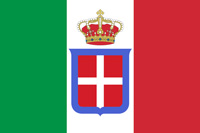World War I (1914-1918)

Eighth Battle of the Isonzo
The Eighth Battle of the Isonzo was fought from October 10–12, 1916 between Italy and Austria-Hungary Austria-Hungary, often referred to as the Austro-Hungarian Empire, the Dual Monarchy, or Austria, was a constitutional monarchy and great power in Central Europe between 1867 and 1918. Austria-Hungary was one of the Central Powers in World War I, which began with an Austro-Hungarian war declaration on the Kingdom of Serbia on 28 July 1914. .
Austria-Hungary, often referred to as the Austro-Hungarian Empire, the Dual Monarchy, or Austria, was a constitutional monarchy and great power in Central Europe between 1867 and 1918. Austria-Hungary was one of the Central Powers in World War I, which began with an Austro-Hungarian war declaration on the Kingdom of Serbia on 28 July 1914. .
Battle
The Eighth Battle of the Isonzo, fought briefly from 10–12 October 1916, was essentially a continuation of attempts made during the Seventh Battle of the Isonzo (14–17 September 1916) to extend the bridgehead established at Gorizia during the Sixth Battle of the Isonzo in August 1916.
Italian Chief of Staff Luigi Cadorna was determined to continue Italian The Kingdom of Italy was a state that existed from 1861, when Victor Emmanuel II of Sardinia was proclaimed King of Italy, until 1946. The state resulted from a decades-long process, the Risorgimento, of consolidating the different states of the Italian Peninsula into a single state. That process was influenced by the Savoy-led Kingdom of Sardinia, which can be considered Italy's legal predecessor state. attacks to the left of the town, a policy that continued during the following (ninth) battle - with an equal lack of success.
The Kingdom of Italy was a state that existed from 1861, when Victor Emmanuel II of Sardinia was proclaimed King of Italy, until 1946. The state resulted from a decades-long process, the Risorgimento, of consolidating the different states of the Italian Peninsula into a single state. That process was influenced by the Savoy-led Kingdom of Sardinia, which can be considered Italy's legal predecessor state. attacks to the left of the town, a policy that continued during the following (ninth) battle - with an equal lack of success.
As with the earlier, Seventh, attack, heavy Italian casualties required that the short, sharp concentrated initiative be called off pending the army's recuperation.
The seemingly interminable Isonzo onslaught was next renewed with the Ninth Battle of the Isonzo on 1 November 1916, the fifth and final attack of the year.
In the battle, the Italian architect Antonio Sant'Elia was killed, a key member of the Futurist movement in architecture.
HISTORY

RESOURCES
This article uses material from the Wikipedia articles "World War", "World War I", and "Eighth Battle of the Isonzo", which is released under the Creative Commons Attribution-Share-Alike License 3.0.
© Stories Preschool. All Rights Reserved.










